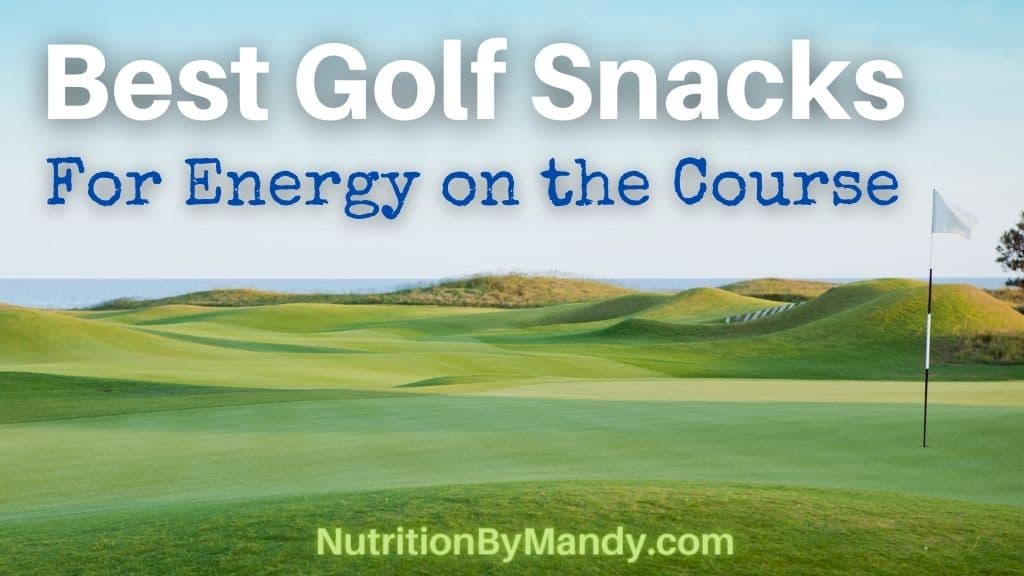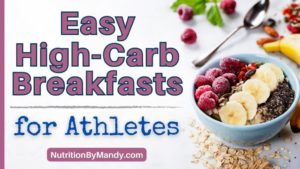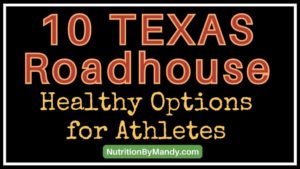Best Golf Snacks for Energy on the Course
Planning the right golf snacks for a day on the course can help ensure you have the energy needed to compete at your best. Let’s take a look at how to plan the best golf snacks to help you stay fueled and hydrated through the last hole.
Carbohydrates for Energy on the Golf Course
Golf is a sport that combines long-duration, low-intensity exercise with brief high-intensity movements. It is a technically demanding sport that requires coordination, precision, and motor control (1). Total energy needs vary based upon the number of holes played, the layout of the course, as well as whether golfers walk the course or ride in a cart.
Carbohydrates in the diet provide the body with the energy needed for activity. Thus, enjoying snacks that are high in carbohydrates can help ensure golfers have the energy needed to perform their best throughout the day.
Carbohydrate-Rich Snacks for Golf
Foods that contain carbohydrates include grain, fruits, starchy vegetables, and dairy. Examples of high-carbohydrate snacks that golfers can eat on the course include:
- Fruit: Bananas, apple slices, oranges, grapes, dried fruit, applesauce squeeze pouches
- Bars: Granola bars, breakfast bars, fig bars, carbohydrate-based sports bars
- Breads and Grains: Mini bagels, dry breakfast cereal, pretzels, pita chips, snack cracke
Golfers following a gluten-free diet can still easily meet their sports nutrition needs with carefully planned snacks. If you need ideas, my blog Gluten Free Carbohydrates for Athletes, may be of help.

Golf Snacks: Mini-Meals
In addition to carbohydrates, plan for snacks that can serve as mini-meals during the day. You can do this by including a source of lean protein with your carbohydrate-rich snack.
Some easy mini-meal snack ideas to throw into your golf bag or cooler include:
- Beef jerky and granola bars
- Peanut butter and jelly sandwich
- String cheese and pretzels
- Turkey wrap
- Apples slices and almonds
- Breakfast bars with nut butter
- Trail mix (made with pretzels, dried fruit, breakfast cereal, nuts, and seeds)
Hydration on the Golf Course
When planning golf snacks, don’t forget about the importance of hydration for athletes. Dehydration can negatively impact sports performance and cognitive function. It also increases your chance of developing a heat-related illness, especially when exercising in a hot and humid environment (2).
Golfers should aim to start the day on the course in a hydrated state. Consuming fluids with your breakfast as well as in the hours leading up to competition is important.
It is recommended athletes drink 5-7 mL/kg of body weight of fluid approximately 4 hours prior to competition (2). For most golfers consuming approximately 2 cups (16 fl oz) of fluid with the pre-competition meal can help with meeting this goal.
Also consider including sodium during this period, either from the food you eat or in a sports drink. The sodium will stimulate thirst, thus encouraging you to drink, and also help your body hold onto the fluid you consume (2).
Hydration During a Round of Golf
During activity, golfers should aim to minimize the amount of dehydration that occurs (2). When you sweat, you lose both fluid and electrolytes. The main electrolyte lost in sweat is sodium. Thus, when considering hydration needs, it is important to focus on replacing both fluids and sodium.
Individuals vary greatly in regard to the amounts of fluids and electrolytes lost in sweat. However, in general, golfers can aim to drink ~3-8 ounces of fluid every 15-20 minutes (0.4-0.8 L per hour) of activity (2, 3).
Drinking a big gulp of water or sports drink is equivalent to approximately 1 ounce of fluid. Thus, golfers should aim for several big gulps from their water bottle every 15-20 minutes while out on the golf course.
However, given the variability in sweat losses amongst athletes, it is best for golfers to work with a Sports Dietitian Nutritionist to develop an individualized hydration plan that meets their specific needs.

Sports Drinks
Packing sports drinks to take with you on the golf course can be a good option. Sports drinks are formulated to contain carbohydrates, sodium, and a small amount of potassium.
When consumed during activity, the carbohydrates in the sports drink provide energy for the working muscles. The sodium and potassium in the sports drink help replace the electrolytes lost in sweat.
When selecting a sports drink, it is important to recognize that not all sports drinks contain the same concentration of carbohydrates, sodium, and potassium. When looking for a sports drink to consume during activity, check for the following (2):
- Carbohydrates: 6-8% carbohydrate concentration (14-19 g carbohydrate/8 oz)
- Sodium concentration: 20–30 meq per L (~110-165 mg sodium/8 oz)
- Potassium concentration: ~2–5 meq per L (~20-50 mg potassium/8 oz)
Review the nutrition facts label of the sports drink you are considering to see if it contains the nutrients you need in the correct amounts for activity.
Reduced or Zero Sugar Sports Drinks
If you have planned a variety of carbohydrate-rich snacks to enjoy on the golf course, a reduced or zero sugar sports drink may be a good option for hydration.
The reduced/zero sugar sports drinks provide the same electrolytes as regular sports drinks with less (or no) carbohydrates. If you are meeting your carbohydrate needs through your snacks, the reduced/zero sugar sports drink can help with replacing the electrolytes lost in sweat.
Individual Packets of Sports Drink Mix
Consider keeping individual packets of sports drink mix with you in your golf bag. You can easily grab a bottle of water from the club house to add in the sports drink mix. This is a great option if you are traveling for competition and want to ensure you have your favorite brand and flavor of sports drink available.
Energy Drinks

Avoid energy drinks when you are spending a day on the golf course. In addition to caffeine, energy drinks often contain a proprietary blend of ingredients. The blend may include ingredients such as: taurine, B Vitamins, guarana, green tea extract, L-carnitine, ginseng, ginger root, and chromium. The combination of ingredients may have a synergistic, stimulatory effect in the body and lead to health concerns.
If you need extra energy while on the golf course, eat one of the snacks you have packed. Foods that are high in carbohydrates provide the body with energy and can give you the boost you need.
Snacks for Golf: What to Eat After a Round of Golf
Following a round of golf, it is important for athletes to focus on recovery nutrition. Recovery nutrition is particularly important for golfers when they will be playing again the same day or the next. Thus, golfers competing in a tournament should make recovery nutrition a top priority.
There are three key areas that golfers should focus on when it comes to recovery nutrition.
- Fluid and Electrolytes: Rehydrate to replace fluid and electrolytes lost in sweat
- Carbohydrates: Refill energy stores used during the activity
- Protein: Build and repair muscles

Recovery Nutrition Snack Ideas for Golfers
Snack ideas that golfers can enjoy following a round of golf include:
- Low-fat chocolate milk with breakfast bars
- Peanut butter and jelly sandwich with low-fat milk
- Greek yogurt, berries, and granola
- Ham and cheese wrap, pretzels, and grapes
- Turkey jerky and granola bars
- Sports bar with sports drink
- Post-workout fruit smoothie
Golfers should then follow-up their snack with a well-balanced meal, post-competition meal within the next couple of hours.
Plan Your Golf Snacks Ahead
As you prepare for your day on the golf course, it is important to take time to plan what snacks you will take with you. Don’t count on being able to grab the snacks you need to support your sports nutrition needs from the club house alone.
Make sure to consider what you will need to carry your snacks with you on the course. Also think about whether or not you will have a cooler to keep foods and drinks cold throughout the day.
Don’t Forget About Food Safety on the Golf Course
Taking steps to minimize the risk of foodborne illness is important. Keep food safety in mind as you prepare your golf snacks to take with you on the course.
Clean Hands Before Eating
The first step to food safety is washing your hands. On the golf course it is not likely you will have the chance to wash your hands with soap and running water each time you want to eat. This being the case, make sure to pack hand sanitizer to take with you on the golf course.
The Centers for Disease Control and Prevention recommends using an alcohol-based hand sanitizer when soap and water are not available. Athletes should choose a hand sanitizer that contains at least 60% alcohol.
To apply the hand sanitizer, rub the gel all over your hands and fingers. Continue rubbing your hands together until they are dry. Make sure to use the hand sanitizer prior to eating.

Hold Cold Food Cold
Another important step to ensure food safety is holding cold food cold. If you plan to take perishable foods, such as meat, cheese, and cut fruit, with you as snacks they need to be stored in a cooler.
Perishable foods should not be left out of the cooler for more than 2 hours. This time frame decreases to 1 hour if the temperature exceeds 90 °F. If food is left out over these time limits, throw it away – it is not worth the risk of getting a foodborne illness.
Use extra caution with maintaining temperature control for the following foods:
- Deli meat
- Cheese, yogurt, and other dairy products
- Mayonnaise or products containing mayonnaise (tuna or chicken salad)
- Eggs (hard-boiled eggs, egg salad)
- Sliced Fruits and Vegetables (especially cut melon)
To reduce the amount of time food is out of the cooler, pack individual servings of items rather than one large container. This way you can grab a snack size serving of the item to enjoy without exposing the rest of the food to the heat.
Practice Your Golf Snacks
During golf practice, try out different types of snacks so you can determine which snacks work best for you. Just as you practice your golf strokes and putting skills, you want to practice your sports nutrition fueling plan.
Knowing you have a sports nutrition plan in place can give you confidence that you are fueled to perform at your best.
Best Golf Snacks for Energy on the Course
You are now set with ideas on the best golf snacks to help you stay fueled and hydrated on the golf course. Remember to plan ahead and pack snacks that can provide you with the energy needed to perform at your best through the last hole.
Starting the day with a healthy breakfast is another key sports nutrition strategy for golfers. For breakfast ideas, check-out my recent blog: 3 Keys to Building Healthy Breakfasts for Athletes.
Join the Nutrition By Mandy Email List & Get a Free Athlete’s Grocery List
Click HERE to join the Nutrition By Mandy e-mail list. When you join you will receive a free athlete’s grocery list to print and take with you to the store.
About Mandy
Mandy is a Sports Dietitian Nutritionist in the San Antonio, TX area. She is a Registered and Licensed Dietitian, a Board-Certified Specialist in Sports Dietetics, a Licensed Athletic Trainer, and is a Certified Exercise Physiologist through the American College of Sports Medicine. Mandy has experience working with athletes at the high school, collegiate, and professional levels. She believes the key to reaching one’s full potential, both in everyday life and in sports performance, relies on a healthy nutritional foundation. Learn more about the work Mandy does here.






